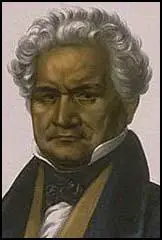Major Ridge

Kah-nung-da-tla-geh (Man Who walks on Mountaintop), a member of the Cherokee tribe, was born at Hiwassee, in 1771. He became a highly respected warrior and became an outspoken critic of the Treaty of Hopewell that had been signed in 1785. Major Ridge, as he became known, took part in many raids on white settlers.
In the 1790s Major Ridge became disillusioned by the large numbers of Cherokees being killed in these raids and began to argue for a negotiated settlement. He established a settlement in Pine Log and attempted to persuade fellow members of the tribe to use spinning wheels and cotton combs provided by the missionaries.
By 1800 Major Ridge was a leading figure in the Cherokee nation. He also began accusing the tribal elder, Doublehead, of getting rich at the expense of the tribe. In August, 1807, Doublehead was murdered. Major Ridge was probably responsible for his death but he was able to enough support from the tribe to prevent being punished by the tribe. Soon afterwards, Major Ridge became head of the Cherokee police, the Lighthorse Patrol.
During the Creek War (1813-1814) Major Ridge raised an army of Cherokee volunteers and fought under Andrew Jackson. He took part in the Battle of Horseshoe Bend in 1814 and four years later led his warriors during the Seminole War.
After the end of the Seminole War he returned home and was elected as Speaker of the Cherokee Council. He also became chief adviser to Chief John Ross. Over the next few years he established himself as one of the richest members of the tribe. This included 280 acres of cultivated land, 1141 peach trees, 418 apple trees, 30 black slaves and numerous Native American slaves.
Like his nephew and protégé, Elias Boudinot, Major Ridge became a supporter of the 1830 Indian Removal Act and in 1832 Boudinot argued that removal was the "course that will come nearest benefiting the nation".
In 1835 Major Ridge, Elias Boudinot and 18 other members of Cherokee tribe signed the Treaty of New Echota. This agreement ceded all rights to their traditional lands to the United States. In return the tribe was granted land in the Indian Territory. Although the majority of the Cherokees, including Chief John Ross, opposed this agreement they were forced to make the journey by General Winfield Scott and his soldiers.
In October 1838 about 15,000 Cherokees began what was later to be known as the Trail of Tears. Most of the Cherokees travelled the 800 mile journey on foot. As a result of serious mistakes made by the Federal agents who guided them to their new land, they suffered from hunger and the cold weather and an estimated 4,000 people died on the journey.
In June, 1839, Major Ridge, his son John Ridge, and Elias Boudinot were murdered by a group of Cherokee warriors who had been opposed to the signing of the Treaty of New Echota.
